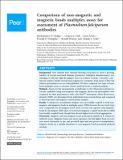Comparison of non-magnetic and magnetic beads multiplex assay for assessment of Plasmodium falciparum antibodies

View/
Publication Date
2019Author
Bartholomew N Ondigo, Gregory S Park, Cyrus Ayieko, Donald D Nyangahu, Ronald Wasswa, Chandy C John
Metadata
Show full item recordAbstract/
Background. New reagents have emerged allowing researchers to assess a growing
number of vaccine-associated immune parameters. Multiplex immunoassay(s) are
emerging as efficient high-throughput assays in malaria serology. Currently, commercial vendors market several bead reagents for cytometric bead assays (CBA) but
relative performances are not well published. We have compared two types of beadbased multiplex assays to measure relative antibody levels to malarial antigens.
Methods. Assays for the measurement of antibodies to five Plasmodium falciparum
vaccine candidates using non-magnetic and magnetic fluorescent microspheres were
compared for their performances with a Bio-Plex200 instrument. Mean fluorescence
intensity (MFI) was determined from individuals from western Kenya and compared
to known positive and negative control plasma samples.
Results. P. falciparum recombinant antigens were successfully coupled to both nonmagnetic and magnetic beads in multiplex assays. MFIs between the two bead types
were comparable for all antigens tested. Bead recovery was superior with magnetic
beads for all antigens. MFI values of stored non-magnetic coupled beads did not differ
from freshly coupled beads, though they showed higher levels of bead aggregation.
Discussion. Magnetic and non-magnetic beads performed similarly in P. falciparum
antibody assays. Magnetic beads were more expensive, but had higher bead recovery,
were more convenient to use, and provided rapid and easy protocol manipulation.
Magnetic beads are a suitable alternative to non-magnetic beads in malarial antibody
serology
Collections
- Department of Zoology [161]
